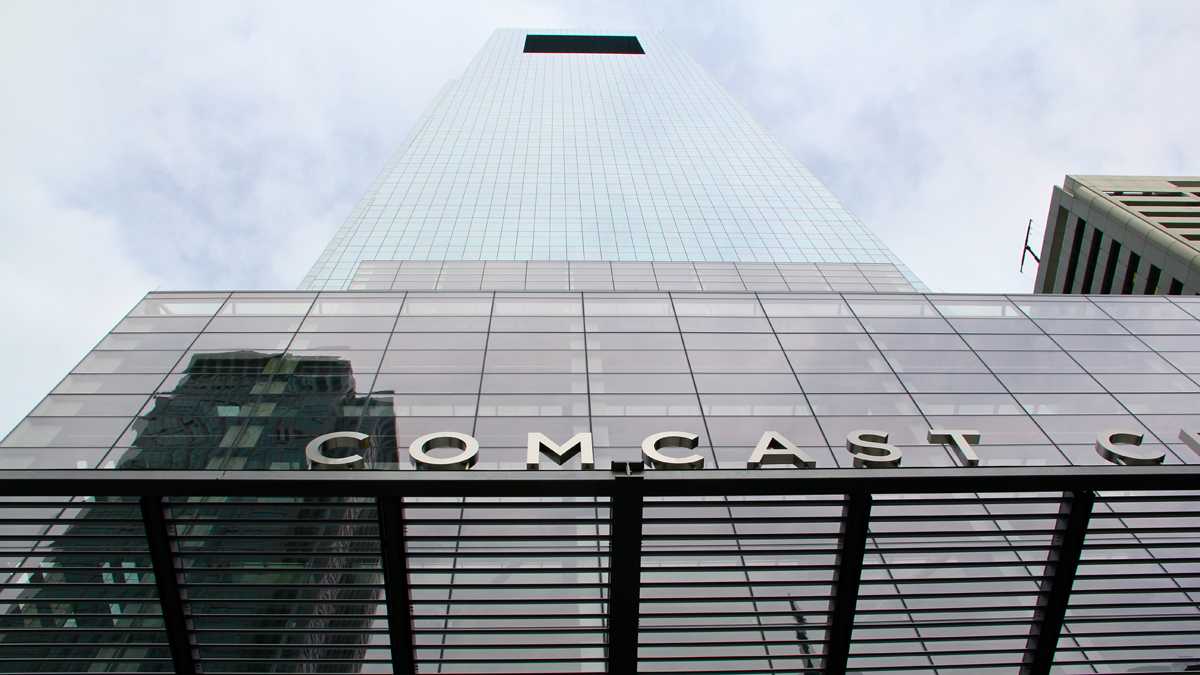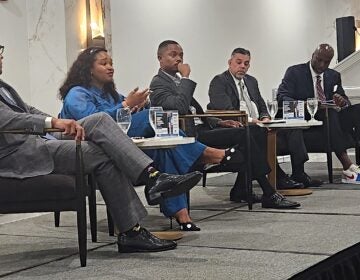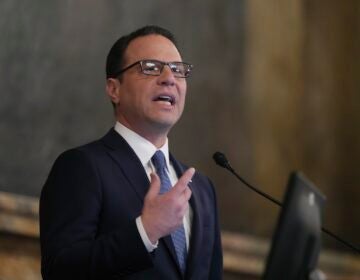CBG to city: Help Comcast customers, but don’t become one

(Emma Lee/WHYY, file)
If the authors of the Nutter administration’s new Comcast report have a single recommendation for the city, it’s this: Get better service for residents and customers, but don’t become a Comcast customer yourself.
Early coverage of the report, a survey and analysis of customer experiences and the city’s needs completed by the consulting firm CBG Communications, highlighted the claim that one out of four Comcast subscribers is “unsatisfied.” A detailed phone survey revealed widespread concerns with billing, service and costs, CBG said. Respondents to an unscientific online poll bandied about with apparent relish such terms as “exorbitant,” “monopoly,” “gouging,” “substandard,” and “horrendous.”
Comcast executives wasted no time firing back, countering that they can prove that much of the report’s data is “flawed” and many of its conclusions “overstated.”
But even as the true levels of customer satisfaction and code violations are being debated, little has been said so far about the report’s core conclusion: that both Comcast and the city’s data networks are badly in need of an upgrade, and the franchise agreement can be used to transform both.
Crabby customers, in other words, are just the tip of the iceberg.
Two sides, same problem
The big story in this report is that, according to CBG, both parties in the franchise negotiation — the city and Comcast — rely on increasingly creaky and outdated networks that won’t be able to meet growing demand.
The franchise agreement, CBG writes, is an opportunity to fix that by establishing new standards of service for both Comcast and the city. The next franchise deal — the fee Comcast pays for the right to climb city poles and dig up city streets — should achieve two main goals, the consultants say:
The city, whose data network is a patchwork of systems managed by a range of vendors, needs a modern, stand-alone, high-speed fiber network of its own It should be comprehensive enough to connect its hundreds of locations, powerful enough to run a wide range of data-hungry applications, flexible enough to adapt to fast-changing demands and secure enough to protect the public;
Comcast, whose network hasn’t been comprehensively upgraded since 2001, needs to add capacity of its own to meet growing demand, and also become formally accountable for meeting specific standards for customer service, system capacity, and code compliance.
The CBG report paints meeting these goals as a win-win. By improving its billing practices, customer services and network capacity, Comcast would address many of the main reasons why customers avoid the provider, the consultants write.
And if the city replaces its antiquated network with something comprehensive and flexible, it can shed unnecessary costs, minimize expensive downtime, and embrace new technology that allows for cheaper and better public services, CBG writes.
Options for upgrades
The consultants lay out two separate proposals for upgrading the city’s network: Ideally, they say, the city should have its own, stand-alone “dark fiber” network. The next-best option is to have dedicated fibers within the Comcast system — fibers that the city can continue using seamlessly should Comcast ever lose its franchise.
The option the consultants specifically reject is to have Comcast itself run the city’s network on its own, through its subsidiary, Comcast Business Services. Comcast has already proposed this so-called “managed network” option, according to the report. If chosen, CBG argues that this option would simply replicate the city’s current problems.
The final option for the city — doing nothing, and maintaining the network status quo — would be almost as expensive as building an entirely new network, CBG writes.
While Nutter has said he “fully embraces” the report’s recommendations, much remains to be learned about what the city wants to do and which of the CBG proposals it will prioritize.
Beyond the big-picture data network issues discussed here, the city has goals involving expanding public-access channels and other community services, particularly those targeted at closing the “digital divide” and getting more and better online access in the city’s many low-income neighborhoods.
And how well CBG’s work will stand up to scrutiny remains to be seen.
Criticism from Comcast
Comcast believes the report has “major flaws” and uses data that “simply isn’t correct.” In an op-ed, one former executive called it “politics as usual.” Among the company’s initial criticisms:
CBG failed to request Comcast data and relied on “unsubstantiated ‘estimates’ of projected problems and recollections of people surveyed.”
Sample sizes used to estimate code violations were too small, and conditions were inaccurately reported
CDG’s findings about busy signals and wait times, “based purely on the general recollections of … customers,” don’t match Comcast’s records, which the company says show FCC compliance.
Comcast will surely have more to say as the franchise negotiations proceed. The same goes for CBG, whose report notes that getting complete data sets from Comcast wasn’t always easy: “some of the information was aggregated rather than providing important details” (Full report, p. 152).
10 things that caught our attention
So with those caveats in mind, here are 10 highlights of the CBG report’s findings and recommendations, starting with the most basic:
1. Everyone’s a customer.
Comcast customers include Philadelphians of every age, race, and economic class. One in five households responding to the phone survey earned less than $25,000 a years. Eight percent earned over $100,000; another eight percent were “seeking employment.” They pay monthly bills ranging from $5 to $758, with the average about $130, and the “most common” around $200. (Full report, p. 44)
2. Many customers are unhappy, and costs are the main concern.
Three out of four say they’re satisfied overall, and picture and sound quality generally rate well. But Comcast subscribers have plenty of complaints: one in three were unhappy with the lack of transparency in billing. Two-thirds reported customer service response times that fall short of FCC standards. Service outages, surprise programming changes, and paying for unwatched channels (especially sports) were all concerns, but nothing matters like cost; it’s the biggest factor in subscribers leaving, and preventing new ones from signing up. (Executive summary, p. 4-5).
3. Comparing Comcast’s rates here to other cities is virtually impossible.
The report concludes that cable pricing has become so complex that CBG can’t assess how Philadelphia customers’ rates compare to other cities. “Because of … bundling, discounts, multi-year contracts, individual equipment and service charges that create a complex cable television bill at best,” CBG wrote, “it is impossible to create an apples-to-apples comparison … of cable television charges consumers pay in Philadelphia when compared to other communities.” (Executive summary, p. 22)
4. You’re right about those messy wires.
If you think you’re seeing lots of untidy cables hanging from telephone poles and exterior walls, CBG says you’re right. Based on a survey sample, they estimate that 13 percent of the 106,000 poles and pedestals used by Comcast have some kind of code violation, such as improperly secured cables or missing support wires. In addition, an estimated 257,000 homes have some kind of code violation, such as an improperly grounded “service drop,” many of which can result in the sorts of services outages that trigger complaints.
5. Comcast’s system is near capacity.
Comcast’s system was built in the 1980s and last upgraded in 2001, the report says. Originally, 95 percent of its capacity was used for television. Now almost half is used up by Internet and telephone services, and demand on the network will only grow. The coming “ultra HD” technology, for example, uses twice as much bandwidth as HD television. “Depending on the length of the franchise renewal term, Comcast may need to upgrade its current system to gain additional bandwidth,” the report says, “particularly if it continues its pattern of allocating additional bandwidth to non-cable TV services.”
6. The city’s network also needs an upgrade — badly.
The report describes the city’s current data network — 338 circuits connecting 208 facilities scattered around the city — as a patchwork that’s inefficient, obsolete and expensive. “Because current network architecture uses multiple technologies that are based on different platforms and standards and is dependent on multiple vendors,” it says, “the City’s flexibility to make changes itself is limited.”
7. A better city system would mean better services.
The report lists a wide range of data-intensive services in use or in planning that it says both save the city money and provide better service to residents, but which are hard to run effectively on the current network.
A sampling of the list: video arraignments of prisoners; security cameras feeding real-time video directly to law enforcement; virtual meetings between city staff and far-flung contractors; expanded use of communications and “customer relations” software for city departments like Revenue and L&I; wifi hotspots citywide; and the use of the cloud to store and share data. Such new systems need a very high level of reliability and security, and needs can change rapidly, so “a high degree of scalability is a priority in the design and implementation of City networks going forward.”
8. A city-run, stand-alone network would be most cost-effective.
The report argues that the city needs to get away from vendor-managed systems and run its own comprehensive network. “The most effective way for the City to achieve the scalability, reliability and consolidated management necessary,” CBG writes, “is to replace the circuits and data transport services the City now contracts for from multiple telecommunications providers … with a consolidated dark fiber optic network linking all City facilities.”
9. Letting Comcast manage a new network would replicate current problems.
The report flatly rejects an option reportedly proposed by Comcast: letting Comcast’s subsidiary, Comcast Business Communications, manage city data on Comcast’s existing fibers (the so-called “managed network” option). Security and reliability would be threatened, standards could not be easily enforced, and few if any cost savings would be realized, CBG writes, leading to a new version of the current problem.
“Under a managed services relationship, network reliability, availability and performance are in the control of the service provider,” the report says. “Service levels depend on provider personnel and contractors who cannot be controlled by the City …. The City’s existing networks are largely vendor-managed networks. Under a managed services arrangement, the City risks replicating the cost, inflexibility, and vendor-coordination issues described in this report …. In CBG’s judgment, the long term cost of a City-controlled dark fiber network is likely to be significantly less than the cost of managed services.”
The report does suggest one cheaper alternative to a stand-alone network. The city could establish its own dedicated fibers inside the Comcast network, CBG writes, “as long as the fiber is dedicated to City use,” and can be used by the city even if Comcast’s franchise eventually ends.
10. The status quo will not save money.
Building an ideal, stand-alone “dark fiber” network would cost about $11.2 million, CBG writes, and doing nothing will cost almost as much: “CBG estimates that over 10 years, the City will spend $10.8 million just to maintain the existing network, without factoring in inflation to current service rates or expansion of network capabilities.” (Full report, p. 148)
The solution to all of these issues, CBG writes, is a franchise agreement that:
Includes franchise fees sufficient to build the new city network, which CBG says can be done at a “reasonable” rate when compared to other cities;
Includes service standards sufficient to minimize service outages and billing issues, and ensure code compliance and customer service standards;
Includes a capacity review every few years, in order to ensure that Comcast is maintaining its network at a level sufficient to deliver the services residents expect.
The Nutter administration, of course, has not said exactly what its negotiating strategy will be, or what it realistically expects to get.
But the mayor did make one notable promise when he released the survey last week: that the city’s Cable Franchise Authority would be adding “four or five” new staff members with the technical expertise needed to enforce the agreement. Whatever the terms are of the final agreement, the mayor promised, the city will have the capacity to enforce them.
And what’s more, the mayor has assured that the entire process will not take place behind closed doors. Public meetings scheduled for the week of April 26 will allow residents to air their own concerns — which Nutter called a “critical aid” to the city’s negotiations.
So much remains to be seen: what the city will push for, what Comcast will prioritize, and how well CBG’s conclusions stand up to closer examination.
But what the CBG report shows clearly is that what’s at stake here is more than relief for agitated cable customers tired of big and unpredictable bills. The question is whether the Nutter administration can negotiate a deal that helps both the city and Comcast replace 20th-century systems with modern networks suited to the demands and opportunities of the future.
WHYY is your source for fact-based, in-depth journalism and information. As a nonprofit organization, we rely on financial support from readers like you. Please give today.




